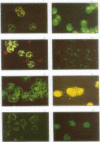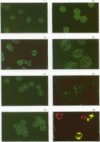Abstract
AIM: To describe the neutrophil fluorescent patterns produced by antineutrophil cytoplasmic antibodies (ANCA) with different antigen specificities, and by other auto- and alloantibodies. BACKGROUND: Most sera from patients with active generalised Wegener's granulomatosis result in diffusely granular cytoplasmic neutrophil fluorescence with internuclear accentuation (cANCA) and proteinase 3 (PR3) specificity. About 80% of the sera from patients with microscopic polyangiitis result in perinuclear neutrophil fluorescence with nuclear extension (pANCA) and myeloperoxidase (MPO) specificity, or a cANCA pattern with PR3 specificity. However, many different neutrophil fluorescence patterns are noted on testing for ANCA in routine immunodiagnostic laboratories. METHODS: Sera sent for ANCA testing, or containing a variety of auto- and alloantibodies, were studied. They were examined by indirect immunofluorescence according to the recommendations of the first international ANCA workshop, and for PR3 and MPO specificity in commercial and in-house enzyme linked immunosorbent assays (ELISA). RESULTS: Sera with typical cANCA accounted for only half of all neutrophil cytoplasmic fluorescence. Other sera had "flatter" fluorescence without internuclear accentuation, and the corresponding antigens included MPO and bactericidal/permeability increasing protein (BPI), but were usually unknown. Peripheral nuclear fluorescence without nuclear extension occurred typically when the antigens were BPI, lactoferrin, lysozyme, elastase, or cathepsin G. Most types of ANA were evident on ethanol fixed neutrophil nuclei. AntidsDNA, antiRo, and antilamin antibodies resembled pANCA. Antimicrobial and antiribosomal antibodies produced cytoplasmic fluorescence, and antiGolgi antibodies, a pANCA. Sera from patients with anti-smooth muscle antibodies were associated with cytoplasmic fluorescence. There was no neutrophil fluorescence with anti-skeletal muscle and anti-heart muscle antibodies, anti-liver/kidney microsomal, antithyroid microsomal, or antiadrenal antibodies. Alloantibodies such as antiNB1 typically resulted in cytoplasmic fluorescence of only a subpopulation of the neutrophils. CONCLUSIONS: The ability to distinguish between different neutrophil fluorescence patterns, and the patterns seen with other auto- and alloantibodies is helpful diagnostically. However, the demonstration of MPO or PR3 specificity by ELISA will indicate that the neutrophil fluorescence is probably clinically significant, and that the diagnosis is likely to be Wegener's granulomatosis or microscopic polyangiitis.
Full text
PDF
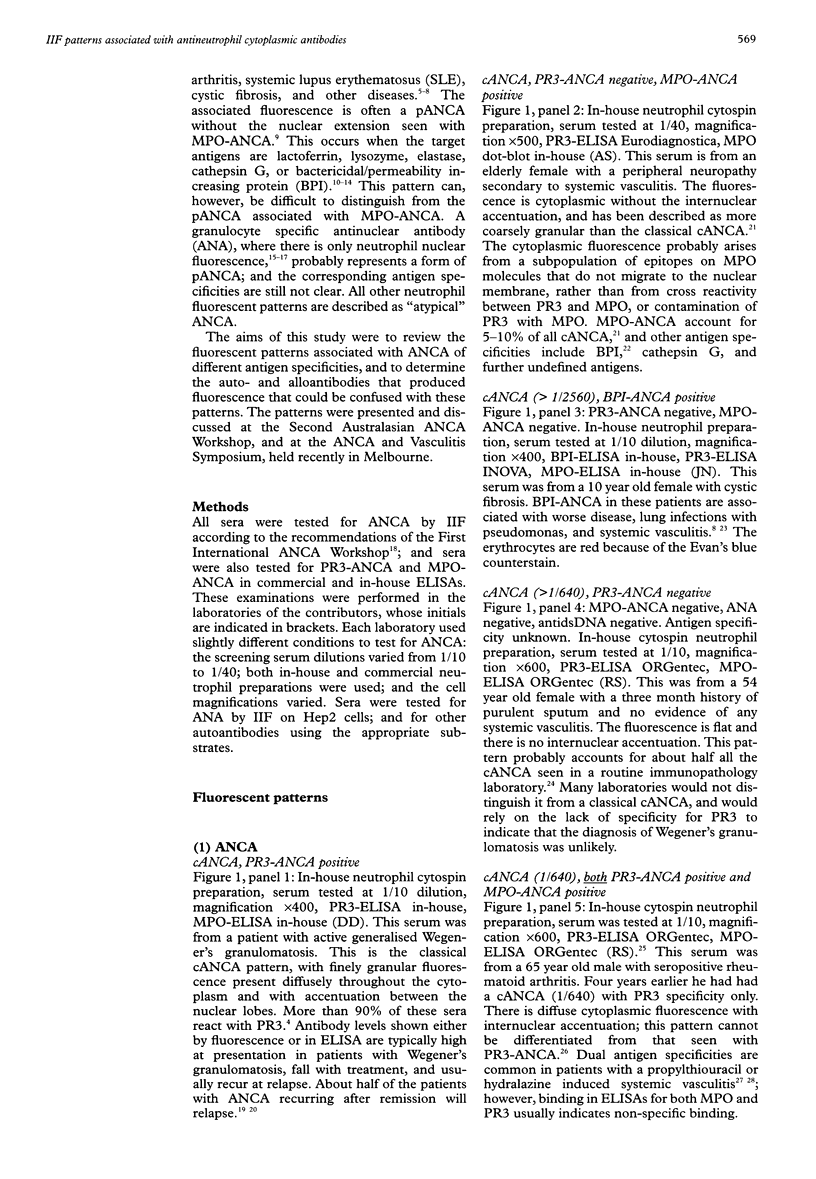
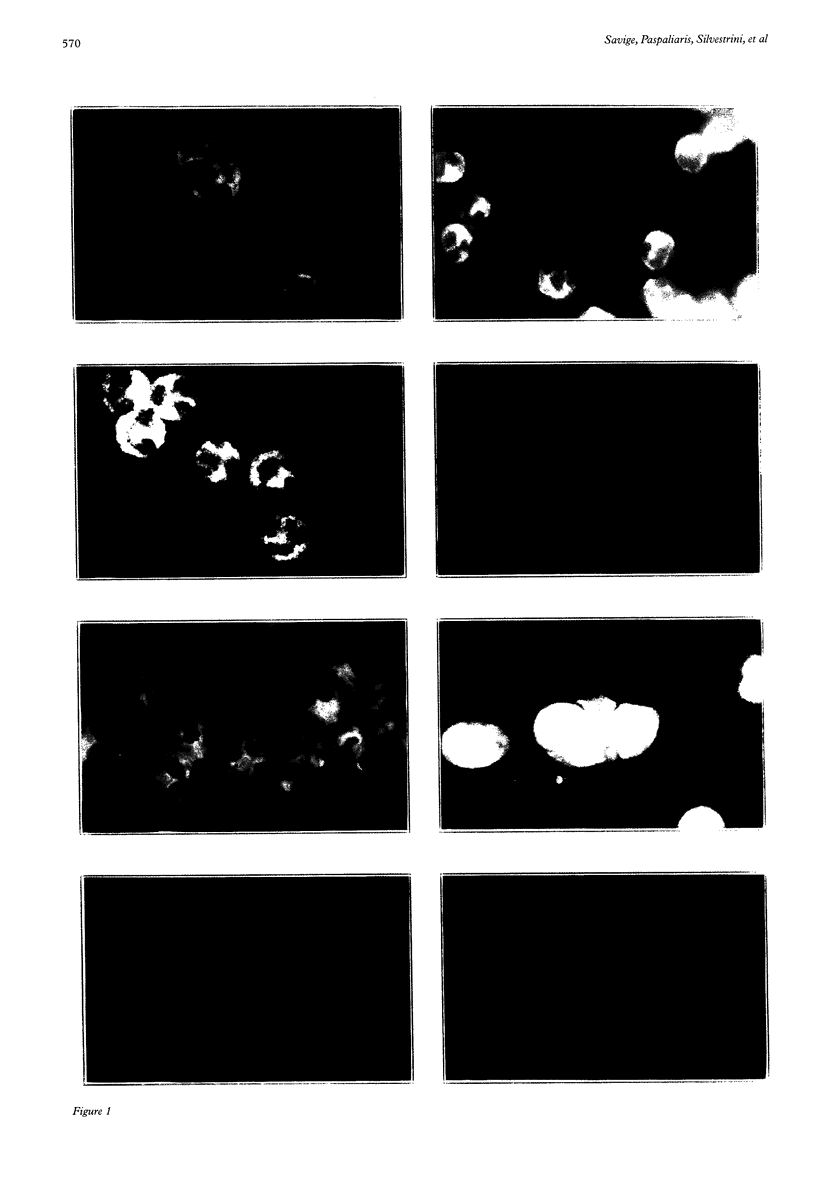

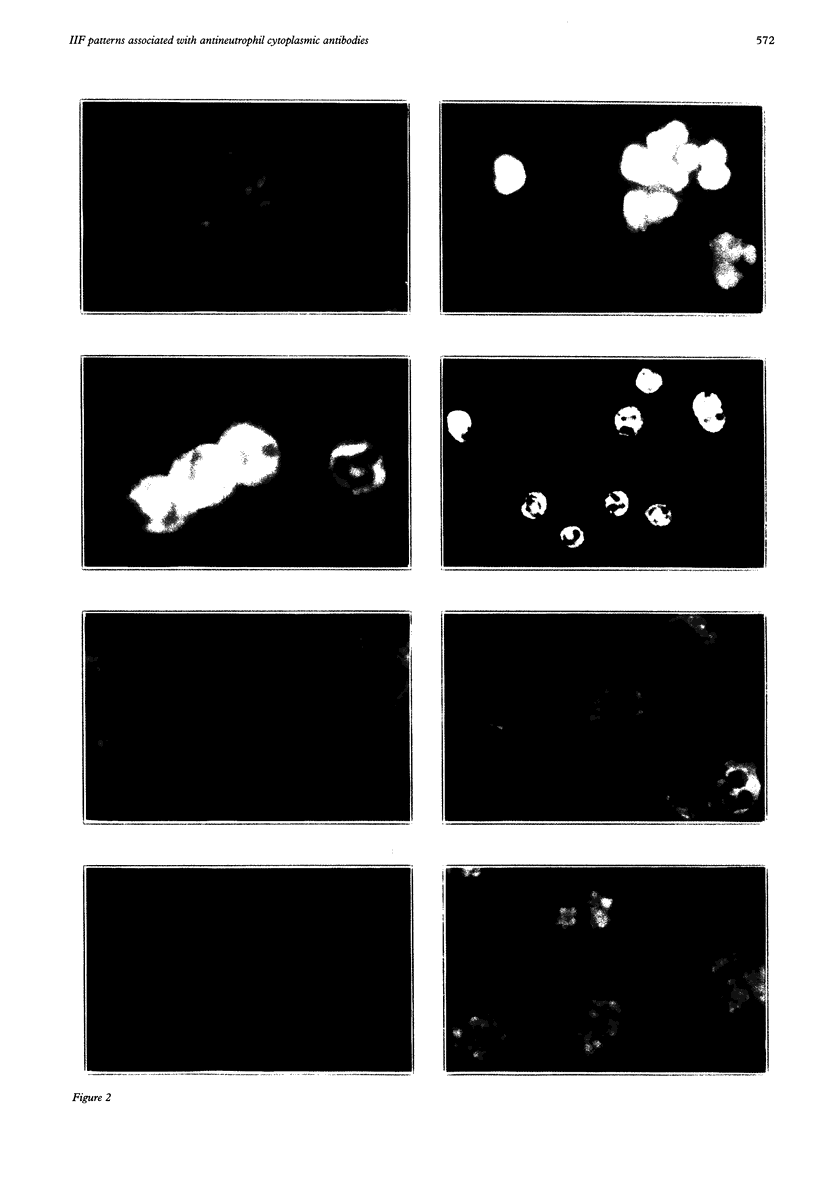
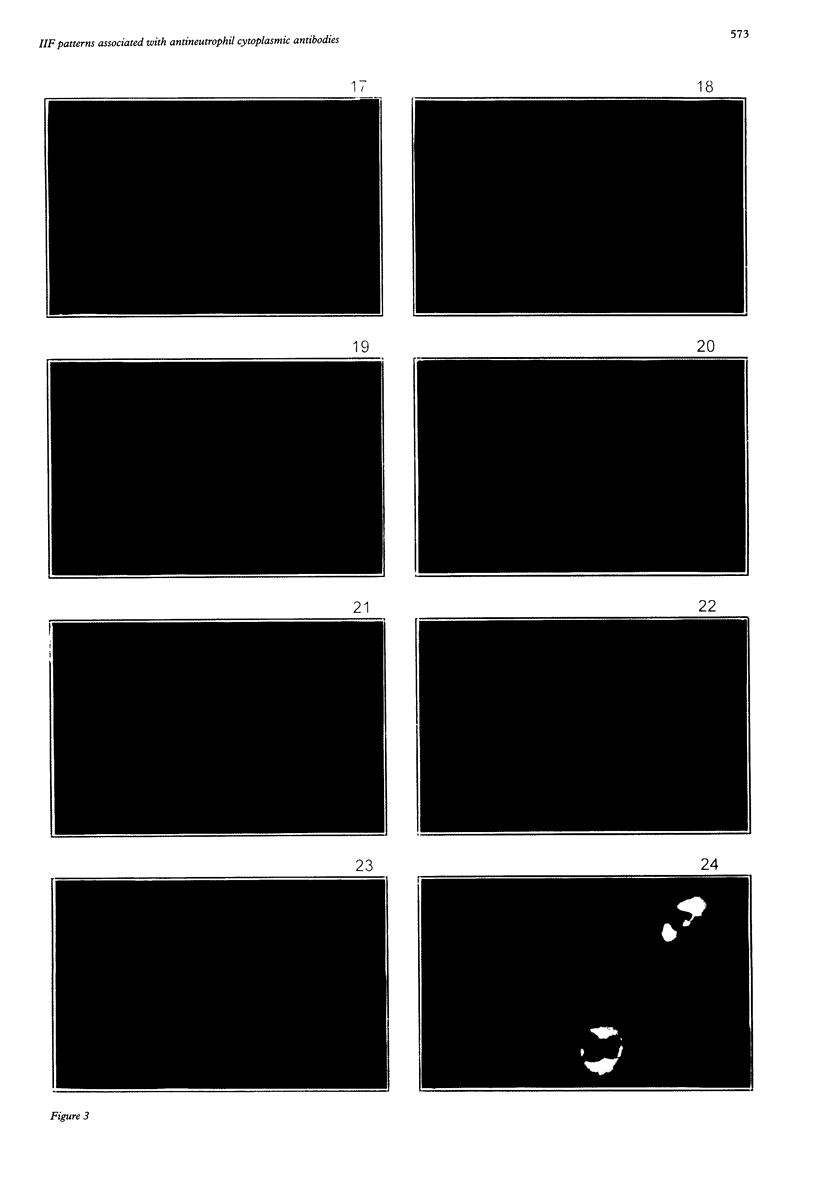
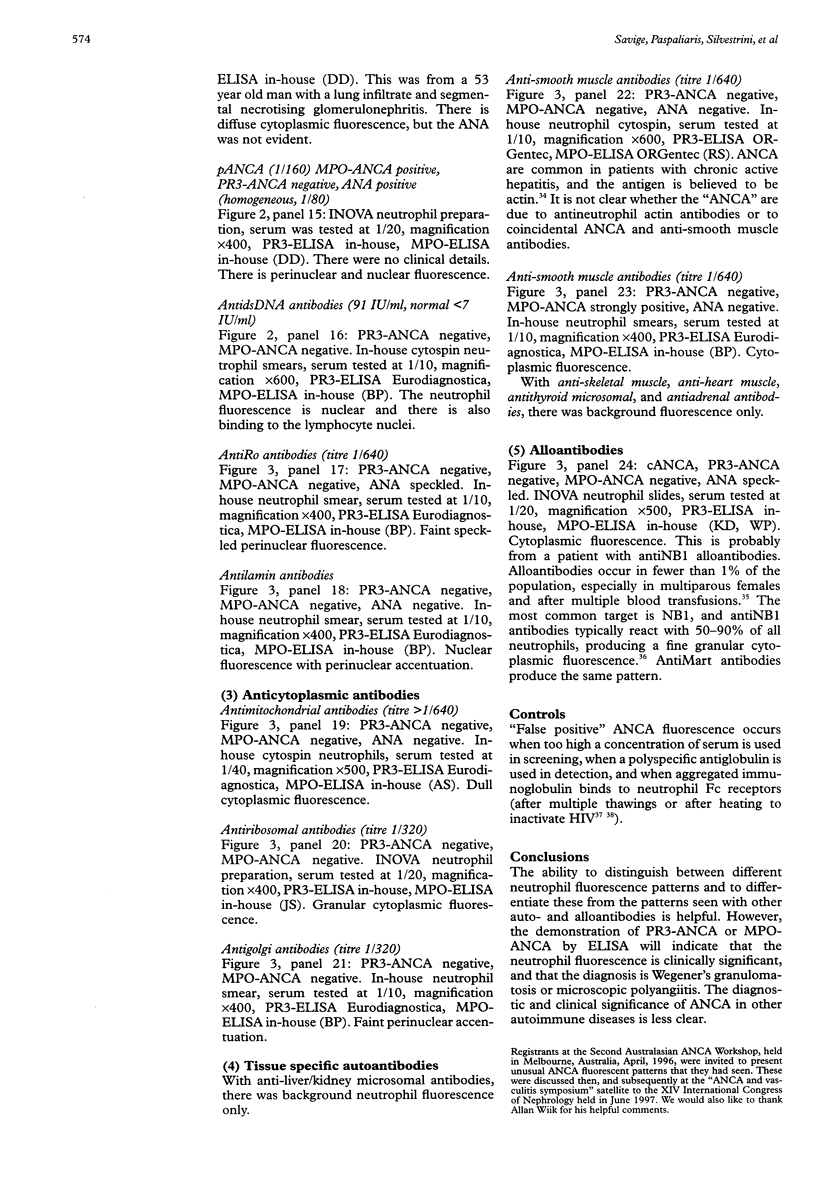

Images in this article
Selected References
These references are in PubMed. This may not be the complete list of references from this article.
- Bang la Cour B., Wiik A., Høier-Madsen M., Baslund B. Clinical correlates and substrate specificities of antibodies exhibiting neutrophil nuclear reactivity--a methodological study. J Immunol Methods. 1995 Dec 1;187(2):287–295. doi: 10.1016/0022-1759(95)00196-7. [DOI] [PubMed] [Google Scholar]
- Charles L. A., Falk R. J., Jennette J. C. Reactivity of anti-neutrophil cytoplasmic autoantibodies with HL-60 cells. Clin Immunol Immunopathol. 1989 Nov;53(2 Pt 1):243–253. doi: 10.1016/0090-1229(89)90054-8. [DOI] [PubMed] [Google Scholar]
- Coremans I. E., Hagen E. C., Daha M. R., van der Woude F. J., van der Voort E. A., Kleijburg-van der Keur C., Breedveld F. C. Antilactoferrin antibodies in patients with rheumatoid arthritis are associated with vasculitis. Arthritis Rheum. 1992 Dec;35(12):1466–1475. doi: 10.1002/art.1780351210. [DOI] [PubMed] [Google Scholar]
- Davenport A. "False positive" perinuclear and cytoplasmic anti-neutrophil cytoplasmic antibody results leading to misdiagnosis of Wegener's granulomatosis and/or microscopic polyarteritis. Clin Nephrol. 1992 Mar;37(3):124–130. [PubMed] [Google Scholar]
- De'Oliviera J., Gaskin G., Dash A., Rees A. J., Pusey C. D. Relationship between disease activity and anti-neutrophil cytoplasmic antibody concentration in long-term management of systemic vasculitis. Am J Kidney Dis. 1995 Mar;25(3):380–389. doi: 10.1016/0272-6386(95)90098-5. [DOI] [PubMed] [Google Scholar]
- Dolman K. M., Gans R. O., Vervaat T. J., Zevenbergen G., Maingay D., Nikkels R. E., Donker A. J., von dem Borne A. E., Goldschmeding R. Vasculitis and antineutrophil cytoplasmic autoantibodies associated with propylthiouracil therapy. Lancet. 1993 Sep 11;342(8872):651–652. doi: 10.1016/0140-6736(93)91761-a. [DOI] [PubMed] [Google Scholar]
- Faber V., Elling P. Leucocyte-specific anti-nuclear factors in patients with felty's syndrome, rheumatoid arthritis, systemic lupus erythematosus and other diseases. Acta Med Scand. 1966 Mar;179(3):257–267. doi: 10.1111/j.0954-6820.1966.tb05457.x. [DOI] [PubMed] [Google Scholar]
- Falk R. J., Jennette J. C. Anti-neutrophil cytoplasmic autoantibodies with specificity for myeloperoxidase in patients with systemic vasculitis and idiopathic necrotizing and crescentic glomerulonephritis. N Engl J Med. 1988 Jun 23;318(25):1651–1657. doi: 10.1056/NEJM198806233182504. [DOI] [PubMed] [Google Scholar]
- Goeken J. A. Antineutrophil cytoplasmic antibody--a useful serological marker for vasculitis. J Clin Immunol. 1991 Jul;11(4):161–174. doi: 10.1007/BF00917422. [DOI] [PubMed] [Google Scholar]
- Koderisch J., Andrassy K., Rasmussen N., Hartmann M., Tilgen W. "False-positive" anti-neutrophil cytoplasmic antibodies in HIV infection. Lancet. 1990 May 19;335(8699):1227–1228. doi: 10.1016/0140-6736(90)92755-7. [DOI] [PubMed] [Google Scholar]
- Lee S. S., Lawton J. W., Chak W. Distinction between antinuclear antibody and P-ANCA. J Clin Pathol. 1991 Nov;44(11):962–963. doi: 10.1136/jcp.44.11.962. [DOI] [PMC free article] [PubMed] [Google Scholar]
- Lock R. J. ACP Broadsheet No 143: January 1994. Detection of autoantibodies to neutrophil cytoplasmic antigens. J Clin Pathol. 1994 Jan;47(1):4–8. doi: 10.1136/jcp.47.1.4. [DOI] [PMC free article] [PubMed] [Google Scholar]
- Nielsen H., Wiik A., Elmgreen J. Granulocyte specific antinuclear antibodies in ulcerative colitis. Aid in differential diagnosis of inflammatory bowel disease. Acta Pathol Microbiol Immunol Scand C. 1983 Feb;91(1):23–26. [PubMed] [Google Scholar]
- Niles J. L., McCluskey R. T., Ahmad M. F., Arnaout M. A. Wegener's granulomatosis autoantigen is a novel neutrophil serine proteinase. Blood. 1989 Nov 1;74(6):1888–1893. [PubMed] [Google Scholar]
- Niles J. L., Pan G. L., Collins A. B., Shannon T., Skates S., Fienberg R., Arnaout M. A., McCluskey R. T. Antigen-specific radioimmunoassays for anti-neutrophil cytoplasmic antibodies in the diagnosis of rapidly progressive glomerulonephritis. J Am Soc Nephrol. 1991 Jul;2(1):27–36. doi: 10.1681/ASN.V2127. [DOI] [PubMed] [Google Scholar]
- Nässberger L., Jonsson H., Sjöholm A. G., Sturfelt G., Heubner A. Circulating anti-elastase in systemic lupus erythematosus. Lancet. 1989 Mar 4;1(8636):509–509. doi: 10.1016/s0140-6736(89)91420-7. [DOI] [PubMed] [Google Scholar]
- Nässberger L., Sjöholm A. G., Jonsson H., Sturfelt G., Akesson A. Autoantibodies against neutrophil cytoplasm components in systemic lupus erythematosus and in hydralazine-induced lupus. Clin Exp Immunol. 1990 Sep;81(3):380–383. doi: 10.1111/j.1365-2249.1990.tb05342.x. [DOI] [PMC free article] [PubMed] [Google Scholar]
- Saxon A., Shanahan F., Landers C., Ganz T., Targan S. A distinct subset of antineutrophil cytoplasmic antibodies is associated with inflammatory bowel disease. J Allergy Clin Immunol. 1990 Aug;86(2):202–210. doi: 10.1016/s0091-6749(05)80067-3. [DOI] [PubMed] [Google Scholar]
- Segelmark M., Baslund B., Wieslander J. Some patients with anti-myeloperoxidase autoantibodies have a C-ANCA pattern. Clin Exp Immunol. 1994 Jun;96(3):458–465. doi: 10.1111/j.1365-2249.1994.tb06051.x. [DOI] [PMC free article] [PubMed] [Google Scholar]
- Snook J. A., Chapman R. W., Fleming K., Jewell D. P. Anti-neutrophil nuclear antibody in ulcerative colitis, Crohn's disease and primary sclerosing cholangitis. Clin Exp Immunol. 1989 Apr;76(1):30–33. [PMC free article] [PubMed] [Google Scholar]
- Spickett G. P., Broomhead V. Formalin fixation and patterns of antineutrophil cytoplasmic antibodies. J Clin Pathol. 1995 Jan;48(1):89–90. doi: 10.1136/jcp.48.1.89. [DOI] [PMC free article] [PubMed] [Google Scholar]
- Stroncek D. F., Egging M. S., Eiber G. A., Clay M. E. Neutrophil alloantibodies react with cytoplasmic antigens: a possible cause of false-positive indirect immunofluorescence assays for antibodies to neutrophil cytoplasmic antigens. Am J Kidney Dis. 1993 Apr;21(4):368–373. doi: 10.1016/s0272-6386(12)80262-9. [DOI] [PubMed] [Google Scholar]
- Tervaert J. W., Stegeman C. A., Kallenberg C. G. Serial ANCA testing is useful in monitoring disease activity of patients with ANCA-associated vasculitides. Sarcoidosis Vasc Diffuse Lung Dis. 1996 Oct;13(3):241–245. [PubMed] [Google Scholar]
- Wiik A. Delineation of a standard procedure for indirect immunofluorescence detection of ANCA. APMIS Suppl. 1989;6:12–13. [PubMed] [Google Scholar]
- Wiik A. Granulocyte-specific antinuclear antibodies. Possible significance for the pathogenesis, clinical features and diagnosis of rheumatoid arthritis. Allergy. 1980 Jun;35(4):263–289. doi: 10.1111/j.1398-9995.1980.tb01768.x. [DOI] [PubMed] [Google Scholar]
- Wiik A., Stummann L., Kjeldsen L., Borregaard N., Ullman S., Jacobsen S., Halberg P. The diversity of perinuclear antineutrophil cytoplasmic antibodies (pANCA) antigens. Clin Exp Immunol. 1995 Jul;101 (Suppl 1):15–17. doi: 10.1111/j.1365-2249.1995.tb06155.x. [DOI] [PMC free article] [PubMed] [Google Scholar]
- Yang J. J., Tuttle R., Falk R. J., Jennette J. C. Frequency of anti-bactericidal/permeability-increasing protein (BPI) and anti-azurocidin in patients with renal disease. Clin Exp Immunol. 1996 Jul;105(1):125–131. doi: 10.1046/j.1365-2249.1996.d01-738.x. [DOI] [PMC free article] [PubMed] [Google Scholar]
- Zhao M. H., Jones S. J., Lockwood C. M. Bactericidal/permeability-increasing protein (BPI) is an important antigen for anti-neutrophil cytoplasmic autoantibodies (ANCA) in vasculitis. Clin Exp Immunol. 1995 Jan;99(1):49–56. doi: 10.1111/j.1365-2249.1995.tb03471.x. [DOI] [PMC free article] [PubMed] [Google Scholar]
- Zhao M. H., Lockwood C. M. ANCA defines the clinical disease manifestations of vasculitis. Sarcoidosis Vasc Diffuse Lung Dis. 1996 Oct;13(3):221–226. [PubMed] [Google Scholar]
- van der Woude F. J., Rasmussen N., Lobatto S., Wiik A., Permin H., van Es L. A., van der Giessen M., van der Hem G. K., The T. H. Autoantibodies against neutrophils and monocytes: tool for diagnosis and marker of disease activity in Wegener's granulomatosis. Lancet. 1985 Feb 23;1(8426):425–429. doi: 10.1016/s0140-6736(85)91147-x. [DOI] [PubMed] [Google Scholar]



